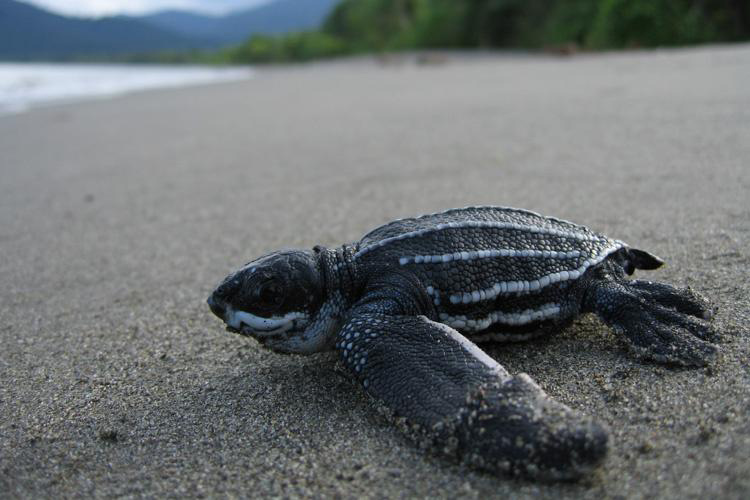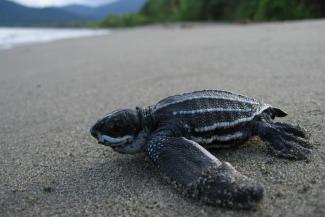
Distribution:
Widely distributed in the Atlantic, Pacific,
to the Antarctic waters. They are known
for their extensive migratory patterns, traveling
long distances between feeding and nesting sites.
Ecosystem:
Open ocean (pelagic) habitats, but they,
also come to coastal areas for nesting. They are
often found in both tropical and temperate waters.
Feeding Habits:
Primarily feed on jellyfish and other soft-bodied
seagrasses and algae. Juveniles are more omnivorous,
invertebrates. They are also known to consume
tunicates, cephalopods, and small fish.
Taxonomy:
Class: Reptilia
Family: Dermochelyidae
Species: Dermochelys coriacea
Overview and Physical Characteristics
The leatherback sea turtle gets its name from its remarkable soft and flexible shell, which is unique among turtles. Rather than the usual hard and bony shell found on all other turtles, the leatherback’s shell is composed of tough, cartilage-type tissue that resembles leather.
The softer shell allows leatherbacks to withstand pressure changes and dive to depths of up to 3937 feet (1200m), making it one of the deepest-diving marine animals. The largest of all sea turtles, leatherbacks can weigh between 600 and 2,000 pounds (272-907 kg) and reach lengths of up to 7 feet (2.1 meters). The leatherback’s flippers are the largest in proportion to its body among sea turtles, allowing it to swim faster than any non-avian reptile.
Habitat and Distribution
Leatherbacks have widest range of all sea turtle species, living in both tropical and temperate waters as far north as Alaska and Norway to the southernmost tips of Africa and New Zealand.
The most pelagic of sea turtles, leatherbacks ply the open waters of the Atlantic, Pacific, and Indian Oceans, regularly migrating across entire ocean basins, from tropical nesting sites to distant feeding grounds in colder waters. In the U.S. leatherbacks nest along the east coast in Florida, Puerto Rico, and the U.S. Virgin Islands.
Ecosystem
Leatherback turtles are critical players in their marine ecosystem, mainly by controlling the populations of their main prey, jellyfish. By eating large quantities of jellyfish, leatherbacks keep runaway populations of jellyfish from decimating zooplankton populations and disrupting marine food webs.
Feeding Habits
As gelatinivores, leatherback turtles specialize in eating jellyfish and tunicates (a type of marine invertebrate also known as sea squirts) but will also eat seaweed, fish, and crustaceans. Leatherback turtles have downward-pointing spines in their throat, which allows jellyfish to be swallowed but prevents them from coming back up. They can consume nearly their own body weight in prey each day.
Behavior and Reproduction
Most of their life leatherback turtles are solitary creatures, only coming together in the open ocean for mating purposes. Male leatherbacks can mate every year, but female leatherbacks only mate every two to three years.
While males never leave the water, females display strong site fidelity, and return to the beach where they were born to lay a clutch of around 80-100 eggs. Each leatherback egg is approximately the size of a billiard ball. After incubating from 60-70 days, hatchlings emerge from the nest and make their way to the open sea.
Fun Fact
Leatherbacks can survive in colder seas than other sea turtles due to insulating properties of a thick, oily layer of connective tissue under their shell and a unique circulatory system that allows them to retain metabolic heat and tolerate lower water temperatures.
This story is part of the “Unleashing the Science” series, showcasing how bureaus within the Department of the Interior produce and apply science to ensure responsible management decisions for our planet now and for the future.
--BOEM--
The Department of the Interior’s Bureau of Ocean Energy Management (BOEM) manages development of U.S. Outer Continental Shelf (OCS) energy, mineral, and geological resources in an environmentally and economically responsible way.



